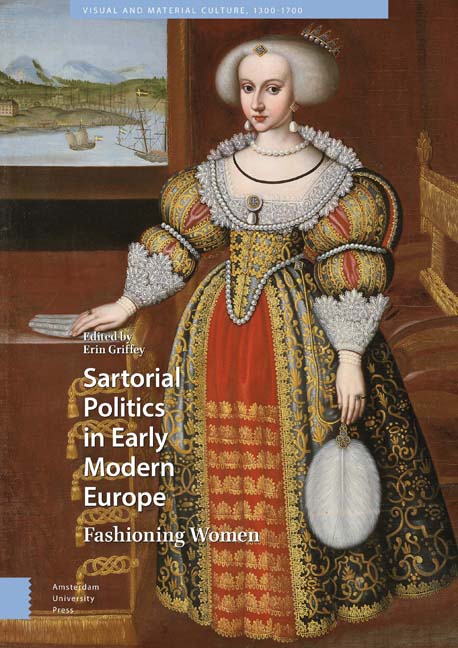Book contents
- Frontmatter
- Acknowledgements
- Contents
- List of Illustrations
- Introduction
- 1 Isabella d’Este's Sartorial Politics
- 2 Dressing the Queen at the French Renaissance Court: Sartorial Politics
- 3 Dressing the Bride: Weddings and Fashion Practices at German Princely Courts in the Fifteenth and Sixteenth Centuries
- 4 Lustrous Virtue: Eleanor of Austria's Jewels and Gems as Composite Cultural Identity and Affective Maternal Agency
- 5 Queen Elizabeth: Studded with Costly Jewels
- 6 A ‘Cipher of A and C set on the one Syde with diamonds’: Anna of Denmark's Jewellery and the Politics of Dynastic Display
- 7 ‘She bears a duke's revenues on her back’: Fashioning Shakespeare's Women at Court
- 8 How to Dress a Female King: Manifestations of Gender and Power in the Wardrobe of Christina of Sweden
- 9 Clothes Make the Queen: Mariana of Austria's Style of Dress, from Archduchess to Queen Consort (1634–1665)
- 10 ‘The best of Queens, the most obedient wife’: Fashioning a Place for Catherine of Braganza as Consort to Charles II
- 11 Chintz, China, and Chocolate: The Politics of Fashion at Charles II's Court
- 12 Henrietta Maria and the Politics of Widows’ Dress at the Stuart Court
- Works Cited
- Index
2 - Dressing the Queen at the French Renaissance Court: Sartorial Politics
Published online by Cambridge University Press: 21 November 2020
- Frontmatter
- Acknowledgements
- Contents
- List of Illustrations
- Introduction
- 1 Isabella d’Este's Sartorial Politics
- 2 Dressing the Queen at the French Renaissance Court: Sartorial Politics
- 3 Dressing the Bride: Weddings and Fashion Practices at German Princely Courts in the Fifteenth and Sixteenth Centuries
- 4 Lustrous Virtue: Eleanor of Austria's Jewels and Gems as Composite Cultural Identity and Affective Maternal Agency
- 5 Queen Elizabeth: Studded with Costly Jewels
- 6 A ‘Cipher of A and C set on the one Syde with diamonds’: Anna of Denmark's Jewellery and the Politics of Dynastic Display
- 7 ‘She bears a duke's revenues on her back’: Fashioning Shakespeare's Women at Court
- 8 How to Dress a Female King: Manifestations of Gender and Power in the Wardrobe of Christina of Sweden
- 9 Clothes Make the Queen: Mariana of Austria's Style of Dress, from Archduchess to Queen Consort (1634–1665)
- 10 ‘The best of Queens, the most obedient wife’: Fashioning a Place for Catherine of Braganza as Consort to Charles II
- 11 Chintz, China, and Chocolate: The Politics of Fashion at Charles II's Court
- 12 Henrietta Maria and the Politics of Widows’ Dress at the Stuart Court
- Works Cited
- Index
Summary
Abstract
During the Renaissance, and despite religious wars and international conflicts, the French court increasingly empowered itself. The queen was closely associated with royal dignity and dynastic prestige. This chapter addresses the dress politics and practices that regulated the appearances of the queen of France in order to display her magnificence and majesty, increasing her importance in the court. Some of these princesses were from top-tier or second-tier foreign dynasties and had to govern the realm during turbulent times. Their looks were an object of attention. The article examines how they were able to mobilise their dressing for strategic ends in terms of expression of their national identity and of their power as regents of the realm for their sons.
Key words: France; queen; dress; clothing; identity; widowhood
During the Renaissance, the royal court became the centre for a codified culture distinct from the rest of society. It produced vestimentary codes and norms that governed an entire scale of appearances that differentiated its members from other social elites. After the disappearance of the last great feudal courts in France, the last of the Valois and the first of the Bourbons worked on the consolidation of the royal court at the end of the sixteenth and beginning of the seventeenth centuries. From the time of François I, there was a commitment to the importance of having a brilliant court, in competition with European courts. It was a question of being ‘the queen of all other courts’, reported the ambassador from Mantua in 1539, a requirement maintained by successive sovereigns in spite of civil and religious conflicts (in 1562–1598) and international conflicts, particularly with Spain, which led to the dissolution of the court for eleven years after 1589. Once peace had been reestablished, the last years of the reign of Henri IV perpetuated the frenzy of courtly luxury in the first decade of the seventeenth century. As the court increasingly empowered itself, setting itself apart from the rest of society, it installed luxury as a sign of entitlement and social distinction.
The court reflected the power of the king and was also the instrument of that power. As it became materialised in an increasingly lavish setting, it also saw the place of the queen being established at its centre.
- Type
- Chapter
- Information
- Sartorial Politics in Early Modern EuropeFashioning Women, pp. 57 - 74Publisher: Amsterdam University PressPrint publication year: 2019



